|
Untitled Document
|
The
History
of Israel
- A Chronological Presentation

3.
The New State (1964 - 1974)
1964
- The Establishment of the PLO
The Palestine Liberation Organization (PLO)
was established in 1964 as an umbrella organization
for the various Palestinian armed groups, with the
explicit aim of achieving, through armed struggle,
the "liberation of Palestine" from
"the Zionist Entity." The West
Bank and Gaza, occupied by Jordan and Egypt respectively,
were at this time not targets of the PLO's struggle
for liberation. In the 1960's, with Egypt's
loss of Gaza in 1956 as a base for guerilla
operations into Israel, Jordan (the West Bank) and
the Syrian Golan Heights became the preferred launching
grounds for attacks on Israel. Israel reacted with
attacks of retribution across the borders into Jordan
and Syria.
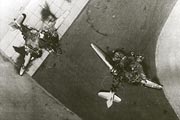 |
 |
Egyptian
aircraft destroyed on the
runway, June 5, 1967.
|
1967
- The Six Day War
In 1966 the Syrian attacks on northern Israel from
the Golan Heights intensified, and in the spring of
1967 the armed clashes between the two countries escalated
further. Fabricated Soviet reports of alleged concentrations
of Israeli troops near the Syrian border made the
Arab leaders step up their threats against Israel,
and on May 15, 1967 the Egyptian president Nasser
ordered his troops across the Suez Canal, into the
Sinai Desert. In the following days Nasser expelled
the UN peace-keeping force and reimposed
the blockade of Eilat.
 |
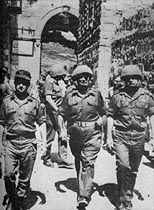 |
|
Israel's Defence Minister,
Moshe Dayan (center), and
Chef of Staff, Yitzchak Rabin
(right), arrive in Jerusalem
after the fall of the city i 1967. |
Israel sought support for the lifting
of the blockade with its Western allies, but was rejected.
The Israeli Prime Minister Levi Eshkol stated in a
speech that Israel did not seek a military confrontation
with its Arab neighbors. With Israel completely isolated,
Jordan and Iraq joined the Egyptian-Syrian defense
pact, while several other Arab countries promised
support for the coming war against Israel. Nasser
declared that the Arabs' objective was the complete
annihilation of Israel.
Surrounded by the Arab armies, which,
measured by troops and equipment, outnumbered the
Israeli armed forces more than two to one, and with
the prospect of being attacked from all sides, the
Israelis chose to strike first. On June 5, 1967 Israeli
warplanes bombed Egyptian airfields, and in a matter
of a few hours eradicated almost the entire Egyptian
air force. Israel appealed to Jordan to stay out of
the fighting, and promised that if it did, Israel
too would refrain from attacking Jordan.
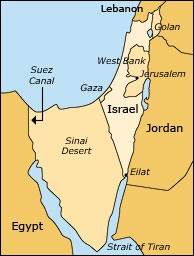 |
 |
|
Israel
and the occupied territories
after the Six Day War in June 1967.
|
But when the Egyptians reported of their allegedly
successful attack on Israel, Jordan that same morning
initiated a massive shelling of West Jerusalem and other
Israeli population centres. Syria bombarded northern
Israel from the Golan Heights, and Jordanian, Syrian
and Iraqi planes attacked other Israeli targets.
Israeli jets were dispatched against Jordan and Syria,
and quickly destroyed both countries' entire air forces.
Left completely without air support, already on the
first day, the Arab armies were doomed, and within
only six days Israel conquered the Gaza Strip, the
Sinai desert, the Golan Heights and the West Bank,
including the Old City of Jerusalem.
1967 - UN Resolution
242 and the "Three Noes"
In the wake of Israel's overwhelming victory
in June 1967, the United Nations Security Council
on November 22 the same year adopted resolution
242, setting the guidelines for future peace
negotiations. The resolution called for a peaceful
solution, negotiated between the parties and based
on the following principle: Israeli withdrawal from
an unspecified part (to be negotiated) of the territory
occupied in June 1967, in exchange for which Israel's
neighbors must recognize the Jewish state, guarantee
its security and respect its borders.
Israel accepted resolution 242, having from the outset
shown willingness to negotiate a withdrawal from most
of the territories in exchange for peace. The entire
Arab World rejected the resolution. At a summit of
the Arab League in Khartoum, already in September
1967, a resolution was adopted containing the following
"three
noes": no to peace with Israel, no to
recognition of Israel, no to negotiations with Israel.
Years later, a number of Arab states have accepted
resolution 242, however in a somewhat liberal interpretation,
according to which Israel must unconditionally surrender
all the territories conquered in 1967.
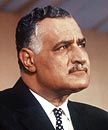 |
 |
| Gamal
Abdel Nasser. |
1969 - The War
of Attrition
The Six Day War had only just ended, when Egyptian
forces started shelling Israeli positions along the
Suez Canal. Israel's answer was to conduct air and
commando raids accross the canal against Egyptian
targets. The Soviet Union sent large amounts of advanced
weaponry accompanied by Soviet military advisors to
Egypt, and in the summer of 1969 Nasser declared a
"war of attrition", aiming to inflict on
Israel the highest possible amount of losses, and
thereby breaking the will of the Israelis to maintain
the occupation of the Sinai Desert. But the strategy
failed, the crisis escalated, climaxing in the summer
of 1970, when Israeli fighter jets downed four MiGs
flown by Soviet pilotes. The US pushed for a cease-fire,
which then came into effect on August 7, 1970. The
War of Attrition ended up claiming several thousand
lives on either side of the Suez Canal.
1970-72 - PLO and
International Terrorism
After the Six Day War various Palestinian armed groups
under the umbrella organization, PLO, continued their
attacks on Israel. However, the Israelis managed fairly
quickly to crush the PLO's infrastructure in the occupied
territories, after which the organization, under its
new
 |
 |
|
PFLP blows up a hijacked passenger
plane, Jordan, September 1970. |
leader, Yasser Arafat, established itself in neighboring
Jordan. The PLO became an influential power in Jordan,
even threatening King Hussein's regime itself, and fighting
broke out between the PLO and the Jordanian army. When
PFLP, a subgroup of the PLO, hijacked four Western airliners
and brought them to Jordan, Hussein had enough, and
ordered his army to attack the refugee camps that served
as bases for the PLO. 2000 guerrillas and many more
innocent civillians were killed.
The surviving PLO members escaped to Syria, where
they received training and equipment from the Syrian
army. Subsequently, the PLO established itself in
neighboring Lebanon, from where they were able to
launch attacks against residential areas in northern
Israel. Following an attack by PLO on an Israeli school
bus, in which 12 people, children and their teachers,
were killed, Israel in May 1970 launched a large military
operation in southern Lebanon, creating a 3 kilometer
(2 mile) wide buffer zone, which temporarily reduced
the Palestinian attacks.
 |
 |
A
masked Palestinian terrorist
during the hostage crisis in
Munich, September 1972.
|
Meanwhile, the PLO developed a new way of placing
its cause on the international agenda. In 1968-72
Palestinian terrorists directed a string of attacks
against international targets. Hijackings of passenger
planes became a specialty, but also other targets
related to Israel or Jews were attacked. One of the
most spectacular attacks was the hostage crisis at
the 1972 Olympics in Munich, which ended with the
massacre of 11 Israeli athletes.
 |
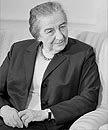 |
|
Golda Meir. |
1973 - The Yom Kippur
War
The cease-fire agreement of August 7, 1970, which
ended the War of Attrition, was broken that very same
day, when the Egyptians moved advanced Soviet weapons
systems all the way up to the Suez Canal. The preparations
for the next all-out war against Israel had begun, and
were, after Nasser's death the same year, taken over by
his successor, Anwar sadat. Syria, like Egypt, received
enormous quantities of weaponry from the Soviet Union,
and in January 1973 the armies of the two countries were
placed under joint command. The Israeli prime minister,
Golda Meir, and her advisors chose
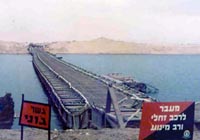 |
 |
An
Israeli pontoon bridge crossing the
Suez Canal, Oktober 1973.
|
to ignore warnings from the Israeli intelligence community
that something was in the offing. The country was therefore
completely unprepared, when Egyptian and Syrian forces
on October 6, 1973, on the Jewish holiday of "Yom
Kippur," initiated a coordinated surprise attack
on the Sinai Peninsula and the Golan Heights.
During the first days of the war, the Arabs made significant
progress. But as the Israeli forces were mobilized,
the fortunes of war turned. Having halted the Arab advance,
Israel succeeded in breaking through enemy lines on
both fronts. When the fighting ended on October 25,
Israeli artillery was within firing range of both Cairo
and Damascus.
 |
 |
|
A lightly wounded General Ariel Sharon
meet with Defense Minister Moshe
Dayan, the Yom Kippur War, 1973. |
Militarily, Israel emerged victorious from the war. But
the Arabs had proved that they still posed a real threat
to Israel, and therefore regarded themselves as victors.
Almost 2700 Israelis were killed in the Yom Kippur War,
and after public protests the Golda Meir government
in April 1974 was forces to resign.
Continue:
Chapter 4 - Peace With The Arabs?
Back
|
Untitled Document
|